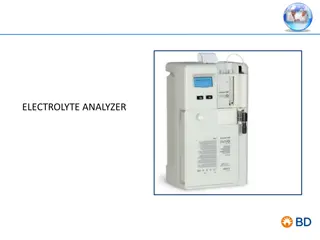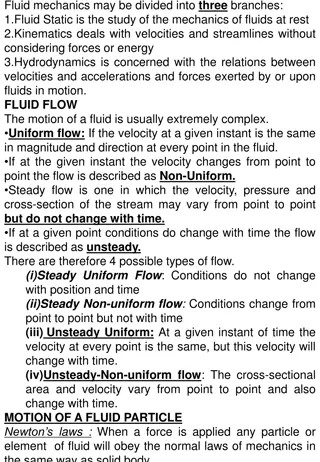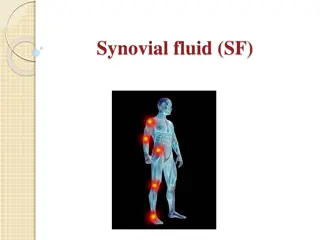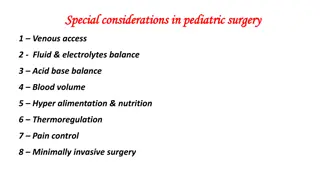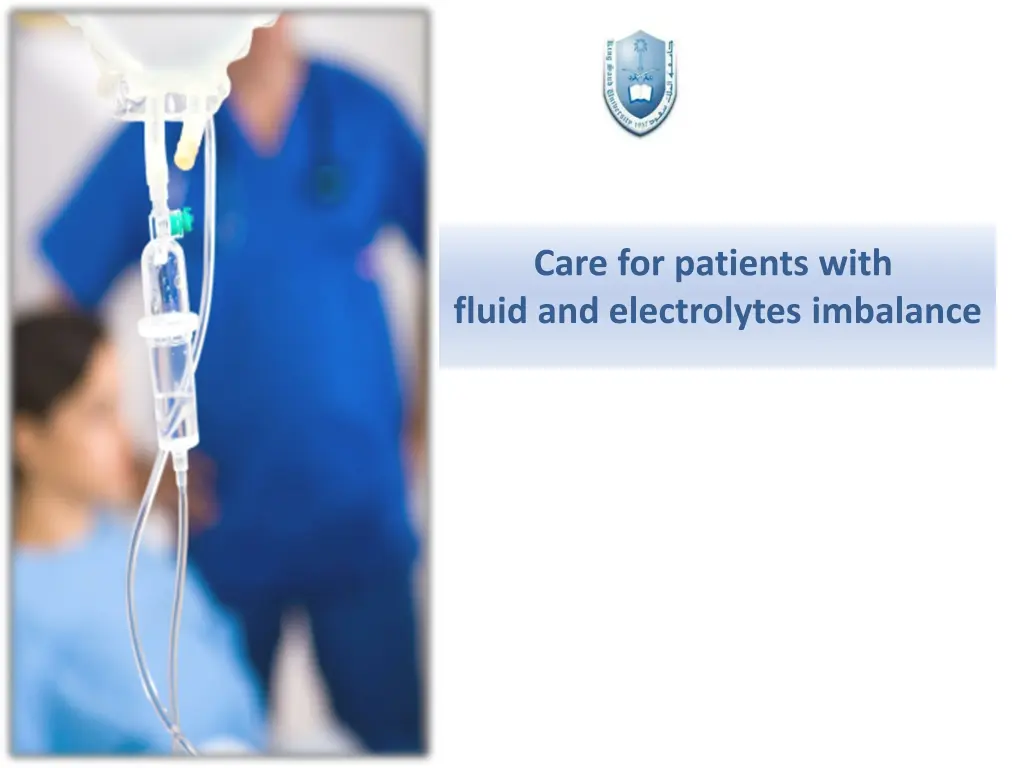
Managing Fluid and Electrolyte Imbalance in Patients
Explore the essentials of fluid and electrolyte balance in healthcare, including anatomy, assessment, and interventions for patients experiencing imbalances. Learn about the importance of maintaining proper hydration and how to assess fluid balance effectively.
Download Presentation

Please find below an Image/Link to download the presentation.
The content on the website is provided AS IS for your information and personal use only. It may not be sold, licensed, or shared on other websites without obtaining consent from the author. If you encounter any issues during the download, it is possible that the publisher has removed the file from their server.
You are allowed to download the files provided on this website for personal or commercial use, subject to the condition that they are used lawfully. All files are the property of their respective owners.
The content on the website is provided AS IS for your information and personal use only. It may not be sold, licensed, or shared on other websites without obtaining consent from the author.
E N D
Presentation Transcript
Care for patients with fluid and electrolytes imbalance
Outline of lecture Introduction Review of Anatomy & Physiology Fluid and electrolytes imbalance Assessing Fluid Balance IV Fluid Replacement Electrolytes Functions and Nursing Responsibilities
Normal anatomy and physiology is divided functionally into the extracellular (ECF = 20% of body weight) and the intracellular fluid spaces (ICF = 40% of body weight) separated by the cell membrane. Water comprises 60% of the body weight of an average adult, the total body water interstitial (extravascular fluid surrounding the cells) fluid space. The ECF is further divided into the intravascular (within the circulation) and the Fluid Functions: 1. Help regulate body temperature 2. Transport nutrients and gases throughout the body 3. Carry cellular waste products to excretion sites Electrolytes : maintaining chemical balance, there are six major electrolytes; sodium, potassium, calcium, chloride, phosphorus, and magnesium. Electrolytes are a major component of body fluids that play important roles in
Fluid and electrolyte imbalances Fluid and electrolyte balance is essential for health. Many factors, such as illness, injury, surgery, and treatments, can disrupt a patient s fluid and electrolyte balance. Even a patient with a minor illness is at risk for fluid and electrolyte imbalance.
Assessing fluid balance There are three elements to assessing fluid balance and hydration status: Review of fluid balance charts; Clinical assessment; Review of blood chemistry.
Review of fluid balance charts; Fluid balance means the amount of fluid intake equal the amount of fluid excreted . Intake include; water, juice, tea and coffe, IV fluid , NG feeding Output include; urine, emesis, NG drainage, and blood drainage. Record all fluid intake in the sheet and calculate the total at the end of each shift Record all fluid output remember if patients on urine catheter each shift empty urine from catheter. IF Intake ( I ) more than Output (O) look for signs of edema IF Intake ( I ) less than Output (O) look for signs of dehydration
I.V. fluid replacement The doctor may order I.V. fluid to maintain or restore fluid balance. I.V. fluid replacement fall into the broad categories of crystalloids and colloids; Colloids - contain larger insoluble molecules (blood, albumin, plasma) used to increase the blood volume following severe loss of blood (haemorrhage) or loss of plasma ( severe burns). Crystalloids contains aqueous solutions of mineral salts or other water-soluble molecules ( salts and sugar.) to correct body fluids and electrolyte deficit.
Isotonic A solution that has the same salt concentration as the normal cells of the body and the blood. Examples: Ringer Lactate . 0.9% NaCl (0.9% NSS ) D5W. Normal saline same tonicity as body Indication: Hypotension (increases BP), Hypovolemia Complications of Isotonic IV fluid overload
Hypertonic A solution with a higher salts concentration than in normal cells of the body and the blood. Examples : D5W in normal Saline solution , D5W in half normal Saline D10W. 5% normal saline D5 Ringers Lactate Indication: low BP slight edema but not w/CHF Complications ; circulatory overload.
Hypotonic A solution with a lower salts concentration than in normal cells of the body and the blood. Examples : 0.45% NaCl . 0.33% NaCl . 45% sodium chloride 5%dextrose water (becomes hypotonic in body) Indication: Dehydration Complications ; May cause edema
Electrolytes : Electrolytes are a major component of body fluids that play important roles i Electrolytes are a major component of body fluids that play important roles in maintaining chemical balance chemical balance, there are six major electrolytes; , there are six major electrolytes; sodium, Na sodium, Na potassium, K potassium, K calcium, Ca calcium, Ca chloride, CL chloride, CL phosphorus, P and phosphorus, P and magnesium. Mg magnesium. Mg n maintaining
Sodium (Na) Normal range: 135-145 mEq/L Functions Helps maintain acid base balance Activates nerve and muscle cells Influences water distribution (with chloride) Assess the patient for fluid status, signs and symptoms Restrict fluid intake. Administer isotonic I.V. fluids Nursing Care for HypoNatremia Assess the patient for fluid status, signs and symptoms Encourage the patient to increase his fluid intake but decrease his sodium intake. Teach the patient and his family how to prevent, recognize, and treat hypernatremia Nursing Care for HyperNatremia
Potassium ( K) Normal Level 3.5 - 5 mEq/L Function Regulates cell excitability & nerve impulse conduction ; muscle contraction and myocardial membrane responsiveness Assess the patient s diet for a lack of potassium., signs and symptoms Administer a potassium replacement as prescribed. Encourage intake of high-potassium foods ,such as bananas, dried fruit, and orange juice. Have emergency equipment available for cardiopulmonary resuscitation and cardiac defibrillation. Nursing Intervention (Hypokalemia)
Potassium ( K) Normal Level 3.5 - 5 mEq/L Function Regulates cell excitability & nerve impulse conduction ; muscle contraction and myocardial membrane responsiveness Assess for signs and symptoms of hyperkalemia. Have emergency equipment available. Administer calcium gluconate to decrease myocardial irritability; Insulin and I.V. glucose to move potassium back into cells; sodium polystyrene sulfonate (Kayexalate) with 70% sorbitol to exchange sodium ions for potassium ions in the intestine Nursing Intervention for (Hyperkalemia) Carefully monitor serum glucose levels
Calcium Normal Level 4.5 5.5 mEq/L Functions Aids in coagulation promotes nerve impulse and muscle contraction/relaxation Assess the patient for signs and symptoms of hypocalcemia, especially changes in cardiovascular and neurologic status and in vital signs. Administer I.V. calcium as prescribed; phosphate-binding antacid. Take seizure or emergency precautions as needed. Encourage the patient to increase his intake of foods that Nursing Intervention (hypocalcemia) are rich in calcium and vitamin D.
Calcium Normal Level 4.5 5.5 mEq/L Functions Aids in coagulation promotes nerve impulse and muscle contraction/relaxation Nursing Intervention (hypercalcemia) Assess the patient for signs and symptoms of hypercalcemia. Encourage ambulation. Move the patient carefully to prevent fractures. Administer phosphate to inhibit GI absorption of calcium. Administer a loop diuretic to promote calcium excretion. Reduce dietary calcium
Magnesium ( Mg) Normal level 1.5 - 2.5 mEq/L Functions: Modifies nerve impulse transmission and skeletal muscle response ; Influences normal function of the cardiovascular system and Na+ and K+ ion transportation Assess the patient for signs and symptoms Administer I.V. magnesium as prescribed. Encourage the patient to consume magnesium-rich foods. If the patient is confused or agitated, take safety precautions; Take seizure precautions as needed. Teach the patient and his family how to prevent, recognize, Nursing Intervention (Hypomagnesemi a) and treat hypomagnesemia
Magnesium ( Mg) Normal level 1.5 - 2.5 mEq/L Functions: Modifies nerve impulse transmission and skeletal muscle response ; Influences normal function of the cardiovascular system and Na+ and K+ ion transportation Review all medications for a patient with renal failure. If reflexes are absent, notify the practitioner. Administer calcium gluconate. Prepare the patient for hemodialysis if prescribed. Instruct the patient to stop taking an antacid, a laxative, or another drug that contains magnesium Teach the patient and his family how to prevent, recognize, and treat hypermagnesemia Nursing Intervention (Hypermagnesemi a)
Phosphorus (p) Normal level 2.5 - 4.5 mg/dl Promotes energy storage and carbohydrate, protein and fat metabolism Functions Assess the patient for signs and symptoms of hypo- phosphatemia, especially neurologic. Administer phosphate supplements as prescribed. Note calcium and phosphorus levels because calcium and phosphorus have an inverse relationship. Assess the patient for signs and symptoms of hyperphosphatemia and hypocalcemia, including tetany and muscle twitching. Advise the patient to avoid foods and medications that contain phosphorus. Administer phosphorus-binding antacids. Prepare the patient for possible dialysis. Nursing Intervention (Hypophosphatemia ) Nursing Intervention Hyperphosphatemia )

